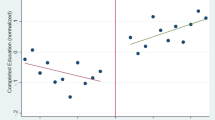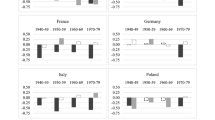Abstract
The analysis is based on individual 1996 TDHS data combined withaggregate data from the 1988 census and the 1991/1992 TDHS. When varioussources of spuriousness are taken into account, it is found that giving awoman more education reduces her fertility much less than suggested byunivariate tabulations of the total fertility rate. Expansion of primaryeducation contributes to only a slightly higher age at first birth, and theeffect on higher-order birth rates is not significant. Changes in post-partum insusceptibility outweigh those in fertility desires and use ofmodern contraception among women not wanting an additional child.Secondary school enrollment influences fertility more markedly, inparticular because of a later first birth. Effects of women's status areestimated in models for actual fertility as well as fertility desires, post-partum insusceptibility and contraceptive use, using up to six macro- ormicro-level indicators. All significant effects suggest that empowerment ofwomen will tend to push fertility down, net of education. The significantinteractions between women's status and education point in differentdirections, but a majority of them indicate that education has the mostpronounced effect on fertility in the more egalitarian regions and amongwomen with relatively high individual status.
Similar content being viewed by others
References
Angeles, G., Guilkey, D.K. and Mroz, T.A., 1998. 'Purposive program placement and the estimation of family planning program effects in Tanzania', Journal of the American Statistical Association 93: 884–899.
Balk, D., 1994. 'Individual and community aspects of women's status and fertility in rural Bangladesh', Population Studies 48: 12–45.
Bankole, A. and Sing, S., 1998. 'Couples' fertility and contraceptive decision-making in developing countries: Hearing the man's voice', International Family Planning Perspectives 24: 15–24.
Bureau of Statistics [Tanzania], 1991. 1988 Population Census. Dar es Salaam.
Bureau of Statistics [Tanzania] and Macro International Inc, 1993. Tanzania Demographic and Health Survey 1991/1992. Columbia, Maryland.
Bureau of Statistics [Tanzania] and Macro International Inc, 1997. Tanzania Demographic and Health Survey 1996. Calverton, Maryland.
Cain, M., 1993. 'Patriarchal structure and demographic change', in N. Federici, K.O. Mason and S. Sogner (eds), Women's Position and Demographic Change. Oxford University Press, Oxford, 43–60.
Caldwell, J., 1980. 'Mass education as a determinant of the timing of fertility decline', Population and Development Review 6: 225–55.
Chahnazarian, A., 1988. 'Determinants of the sex ratio at birth: Review of recent literature', Social Biology 35: 214–235.
Cleland, J. and Wilson, C., 1987. 'Demand theories of the fertility transition: An iconoclastic view', Population Studies 41: 5–30.
Cleland, J. and Rodriguez, G., 1988. 'The effect of parental education on marital fertility in developing countries', Population Studies 42: 419–442.
Cochrane, S.H., 1979. Fertility and Education: What do We Really Know? The Johns Hopkins University Press, Baltimore.
Desai, S. and Alva, S., 1998. 'Maternal education and child health: Is there a strong causal relationship?', Demography 35: 71–81.
Diamond, I., Newby, M. and Varle, S., 1999. 'Female education and fertility: Examining the links', in C.H. Bledsoe, J.B. Casterline, J.A. Johnson-Kuhn and J.G. Haaga (eds), Critical Perspectives on Schooling and Fertility in the Developing World. National Academy Press, Washington.
Eloundou-Enyegue, P.M., 1999. 'Fertility and education: What do we know now?', in C.H. Bledsoe, J.B. Casterline, J.A. Johnson-Kuhn and J.G. Haaga (eds), Critical Perspectives on Schooling and Fertility in the Developing World. National Academy Press, Washington.
Easterlin, R.A. and Crimmins, E., 1985. The Fertility Revolution: A Supply-Demand Analysis. University of Chicago Press, Chicago.
Goldstein, H. et al., 1998. A User's Guide to MlwiN. Institute of Education, University of London.
Heckman, J. and Walker, J., 1990. 'The relationship between wages and income and the timing and spacing of births: Evidence from Swedish longitudinal data', Econometrica 58(1): 411–41.
Hill, K. and Upchurch, D.M., 1995. 'Gender differences in child health: Evidence from the Demographic and Health Surveys', Population and Development Review 21: 127–152.
Hyde, K.A.L., 1993. 'Sub-Saharan Africa', in E.M. King and M.A. Hill (eds), Women's Education in Developing Countries. The Johns Hopkins University Press, Baltimore.
Jejeebhoy, S.J., 1995. Women's Education, Autonomy and Reproductive Behaviour: Experience from Developing Countries. Clarendon Press, Oxford.
Kasarda, J.D., Billy, J.O. and West, K. 1986. Status Enhancement and Fertility: Reproductive Responses to Social Mobility and Educational Opportunity. Academic Press, New York.
Kirk, D., 1996. 'Demographic transition theory', Population Studies 50: 361–387.
Kirk, D. and Pillet, B., 1998. 'Fertility in Sub-Saharan Africa in the 1980s and 1990s', Studies in Family Planning 29: 1–22.
Kravdal, Ø, 1998. 'The importance of women's education and status for fertility in Tanzania in the 1990s', Working Paper 98/29. Department of Economics, University of Oslo.
Kritz, M.M., Makinwa-Adebusoye, P. and Gurak, D.T., 1997. 'Wife's empowerment and fertility in Nigeria: The role of context', Working Paper 97.05. Population and Development Program, Cornell University.
Larsen, U., 1997. 'Childlessness, subfertility and infertility in Tanzania', Studies in Family Planning 27: 18–28.
Larsen, U. and Hollos, M., 1998. 'Fertility decisions among the Pare of Northern Tanzania: The changing context of husband-wife relations', Presented at the IUSSP Seminar on Reproductive Change in Sub-Saharan Africa. Nairobi.
Lesthaeghe, R., Vanderhoeft, C., Gaisie, S. and Delaine, G., 1989. 'Regional variation in components of child-spacing: The role of women's education', in R. Lesthaeghe (ed), Reproduction and Social Organization in sub-Saharan Africa. University of California Press, Berkeley.
Lloyd, C.B. and Blanc, A.K., 1996. 'Chlidren's schooling in sub-Saharan Africa: The role of fathers, mothers and others', Population and Development Review 22: 265–298.
Lloyd, C., Kaufman, C. and Hewett, P., 1998. 'Education transitions in sub-Saharan Africa: Implications for fertility change', Presented at the IUSSP Seminar on Reproductive Change in Sub-Saharan Africa. Nairobi.
Lockwood, M., 1998. Fertility and Household in Tanzania. Clarendon Press, Oxford.
Mason, W.M., Young, G.Y. and Entwistle, B., 1984, 'Contextual analysis through the multilevel linear model', Sicological Methodology 14: 72–103.
Mason, K.O., 1989. 'The impact of women's social position on fertility in developing countries', in J.M. Stycos (ed), Demography as an Interdiscipline. Transaction Publishers, Brunswick, 100–127.
Mason, K.O., 1993. 'The impact of women's position on demographic change during the course of development', in N. Federici, K.O. Mason and S. Sogner (eds), Women's Position and Demographic Change. Oxford University Press, Oxford, 19–42.
Mason, K.O., 1997a. 'Gender and demographic change. What do we know?', in G.W. Jones, R.M. Douglas, J.C. Caldwell and R.M. D'souza (eds), The Continuing Demographic Transition. Clarendon Press, Oxford, 158–182.
Mason, K.O., 1997b. 'How family position influences marital women's autonomy and power in five Asian countries', Presented at the CICRED Seminar on Women and the Family. Paris.
Mason, K.O., Smith, H.L. and Morgan, S.P., 1998. 'Muslim women in the non-Islamic countries of Asia: Do they have less autonomy than their non-muslim neighbours?', Presented at the Annual Meeting of the American Sociological Association. San Fransisco.
Mturi, A.J. and Curtis, S.L., 1995. 'The determinants of infant and child mortality in Tanzania', Health Policy and Planning 10: 384–394.
Mturi, A.J. and Hinde, A.P.R., 1994. 'Fertility decline in Tanzania', Journal of Biosocial Science 26: 529–538.
Mukangara, F. and Koda, B., 1997. Beyond Inequalities. Women in Tanzania. Southern African Research and Documentation Centre, Harare (Zimbabwe).
Niraula, B.B. and Morgan, S.P., 1996. 'Marriage formation, post-marital contact with natal kin and autonomy of women: Evidence from two Nepali settings', Population Studies 50: 35–50.
Planning Commission, 1992. 'National Population Policy', President's office, Dar es Salaam. Planning Commission, 1998. 'National Population Policy', Draft from President's office, Dar es Salaam.
United Nations, 1989. 'Case studies in population policy: United Republic of Tanzania', Population Policy Paper 22. Department of International Economic and Social Affairs, New York.
Author information
Authors and Affiliations
Rights and permissions
About this article
Cite this article
Kravdal, Ø. Main and Interaction Effects of Women's Education and Status on Fertility: The Case of Tanzania. European Journal of Population 17, 107–135 (2001). https://doi.org/10.1023/A:1010725506916
Issue Date:
DOI: https://doi.org/10.1023/A:1010725506916




